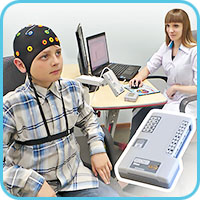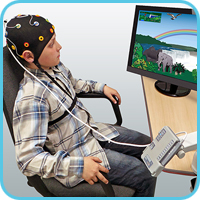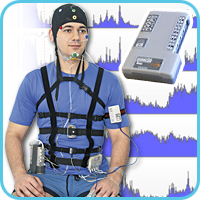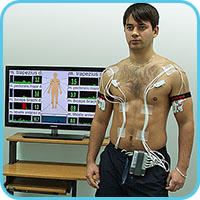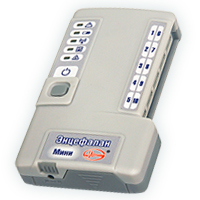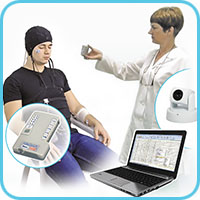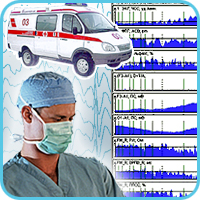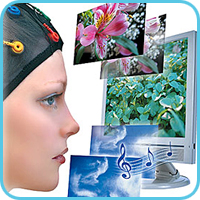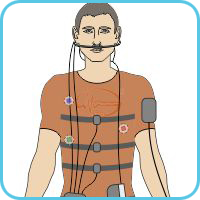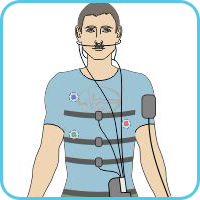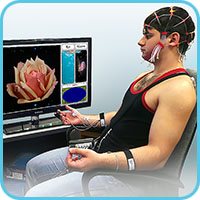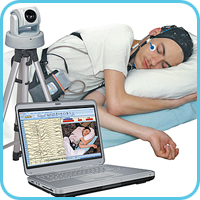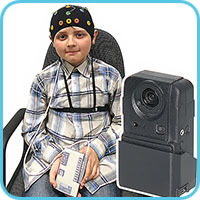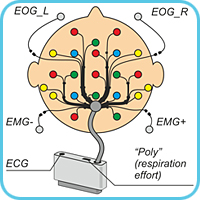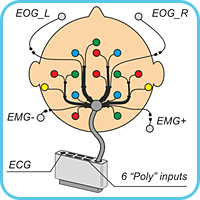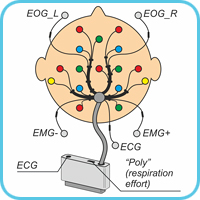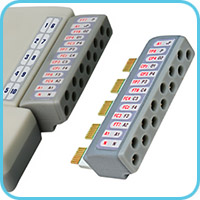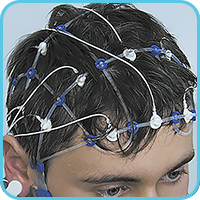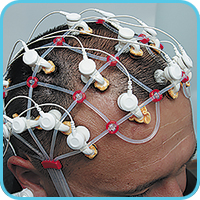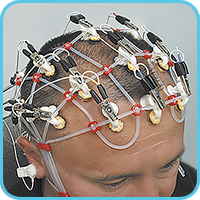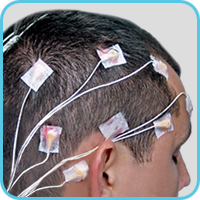Main technical characteristics of autonomous patient transceiver-recorder ABP-10
Medicom MTD. Medical equipment for electrodiagnosis, rehabilitation and research
Phones: +7 (8634) 62-62-42, 62-62-43, 62-62-44, 62-62-45.
www.medicom-mtd.com
Electroencephalograph-recorder "Encephalan-EEGR-19/26". "Mini" modification
Four options for using the basic device вАУ autonomous patient transceiver-recorder ABP-10 вАУ with a large number of various wireless modules and sensors expand the field of application:
Low-channel portable electroencephalograph-recorder
Used for short-term and long-term EEG studies in telemetric or autonomous (EEG-Holter) modes and is efficiently applied for:
- differential diagnosis of epilepsy (applied with software "Encephalan-Video") mainly in children and infants;
- continuous EEG monitoring in emergency rooms and intensive care units with the help of software "Encephalan-NM" and software "Encephalan-CFM", including the pronouncement of brain death;
- psychophysiological research;
- neuromarketing research.
Biofeedback and neurofeedback equipment
The main features of the wireless electroencephalograph, modification вАЬMiniвАЭ for biofeedback training, are:
- multiparameter record (10 or more), which allows creating and using more effective scenarios of biofeedback procedures in sport, education, science and for special training and rehabilitation;
- professional neurophysiological support using software for electroencephalograpical studies and additional software.
Polysomnograph
for sleep cardiorespiratory disorders analysis
Electroencephalograph-recorder "Encephalan-EEGR-19/26, "Mini" modification in combination with software "Encephalan-PSG" and required wireless modules and sensors is effectively used as polysomnograph .
Two variants of polysomnograph based on patient transceiver-recorder ABP-10 provide professional level of sleep diagnostics in compliance with the AASM Standards.
Patient transceiver-recorder ABP-10 allows carrying out studies in telemetric or autonomous (PSG-Holter) mode.
Multifunctional multichannel polygraphic system
A unique option of combination of two or three patient transceivers-recorders ABP-10 with additional modules
and sensors allows creating multifunctional polygraphic systems with synchronous recording of more than 30 different signals.
All physiological signals are synchronously recorded and displayed as the result of a single device operation during monitoring or data analyzing.
Light weight of device, an option of quick modification of system configuration and high software functionality provide an effective application
of the system in sports and occupational medicine, and scientific research.
• Electroencephalograph in a telemetric or autonomous (Holter EEG) mode
is used for short-term and continuous EEG studies вАУ in a hospital room or at the patient's home, including EEG-video monitoring for the differential diagnosis of epilepsy
Autonomous patient transceiver-recorder ABP-10 in the telemetric mode provides data transition to a doctor's computer via wireless Bluetooth channel,
which eliminates the need for communication cables and allows placing electroencephalograph away from the doctorвАЩs computer everywhere in the doctorвАЩs office
or patientвАЩs ward based on the convenience of the study.
Wireless stimulation control unit provides carrying out of hardware functional tests which are common for routine EEG studies: light and audio stimuli.
Functional tests for electrostimulation are carried out by means of wireless electrostimulator.
During the short-term EEG-studies EEG-9 connector is connected to the patient transceiver-recorder. EEG-9 connector allows using EEG electrodes
with touchproof connector (cup or bridge electrodes).
Adhesive EEG electrodes are used during continuous neuromonitoring in the intensive care units and emergency room.
The main software EEG studies "Encephalan-EEGR" provides all the common functionality that is required for EEG record and analysis: monitoring and visual EEG analysis, creation and use of montages and study scenarios, processing with various quantitative methods of EEG analysis, study results presentation, printing, storage in a data-base, etc.
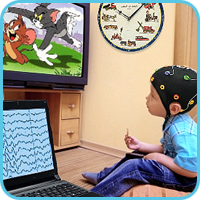
New technology of ambulatory-telemetric studies
allows alternating data recording in the ambulatory and telemetric mode
and provides additional opportunities for functional tests in the telemetric mode. During long-term autonomous ambulatory EEG registration against
the background of drug therapy, when it is necessary to carry out functional tests in order to evaluate the dynamics of the patientвАЩs state
after taking the medicine.
Continuous autonomous EEG-study (Holter-EEG) is effective for:
- Evaluation of psychogenic disorders of not defined genesis, which are manifested under conditions of natural environment and behavior.
- Detection of pathological manifestations, such as paroxysmal epileptic states, transient ischemic attacks, and others.
- Differential diagnosis of epilepsy, types of seizure and syndromes, especially in irregular and illdefined paroxysm.
- Control in drugs administration.
- Long-term EEG monitoring of non-transportable patient in any hospital department or during their continuous transportation.
All data is recorded onto the memory card integrated into the patient transceiver-recorder ABP-10.
During the research the patient, their relatives and medical staff can use a specialized digital voice recorder вАУ
event marker for recording marks and verbal comments on changes in patient's state and digital events logging.
When the study is completed, all the data is transferred from the memory card of patient transceiver-recorder ABP-10
and digital voice recorder to the doctor's computer and accurately synchronized in time.
Sales package of electroencephalograph easily fits in a compact carrying case and includes the patient transceiver-recorder ABP-10, phono-photostimulator, a set of electrodes and a portable computer.
Portability of patient transceiver-recorder ABP-10, backup of all recorded data on the internal memory card and wireless data transmission to the computer provide high reliability and noise immunity when using in the emergency room and intensive care units (including in neonatology).
Special connector EEG-9 with defibrillation proof provides stable performance of the electroencephalograph when using a cardiac defibrillator.
Cerebral functions monitoring with optional software "Encephalan-CFM" is used to assess the functional state of the brain and neurological status in patients with ischemic stroke and unconscious post-comatose states, to detect paroxysmal brain activity, its severity and frequency, and to control the dynamics of a patient state in therapeutic intervention and the states of asphyxia, low cerebral perfusion and brain damages in children (mainly newborns) as well as in adults.
Neuromonitoring with optional software "Encephalan-NM"
is meant for long-term multiparametric monitoring for continuous analysis of EEG dynamics and other physiological signals in order to control the current state,
for timely diagnosis of central nervous, cardiovascular and respiratory systems disorders, assessment of the anaesthetic depth and decision making
on the necessary therapeutic interventions, etc.
"Encephalan-NM" provides calculation and visualization of trends of different physiological parameters of the CNS, ANS and the cardiorespiratory system
in the same time scale with an option of changing the duration of time position from 10 to 300 s.
"Encephalan-CFM" and "Encephalan-NM" can be used separately as optional software to the main software "Encephalan-EEGR", but the most informative and effective monitoring of parameters is provided at their simultaneous operation.
"95 percent of thinking takes place in our unconscious minds. We need to use better research methods
that penetrate more deeply into the human mind to get what people donвАЩt know and guess at the level of consciousness, but in fact they know it."
Professor Gerald Zaltman, founder of neuromarketing
"By looking at the EEG readout we can tell whether theyвАЩre disengaged or engaged.
And weвАЩve found that storyline wins every time."
Steve Sands (Sands Research)
Neuromarketing is a modern developing field of research of consumers' psychology that uses integrated biometric research methods of the brain electrical activity parameters, skin, and muscle movements in order to determine the images, which a focus group reacts most actively to. It helps to build a visual range of incentives more accurately and efficiently taking into account the feelings and emotions of customers for subsequent marketing activities.
A rational explanation of consumer choice is not always the real motive. In the most cases, consumers buy an emotion associated with a product rather than its functional characteristics, and then rationalize retroactively their choices.
So-called "background sample", namely record of psychophysiological parameters in the normal state when presenting neutral images, is carried out before the main test to calibrate the responses.
Autonomous patient transceiver-recorder ABP-10 depending on connected modules and sensors records EEG (from 4 to 9 derivations), respiration effort (abdominal and thoracic), heart rate, galvanic skin response, photoplethysmogram, tremor (1-4 sensors).
Software "Encephalan-AVS" allows displaying audiovisual images and synchronously recording physiological parameters as well as creating study scenario where significant image (for a test personвАЩs reaction finding out) is being presented at the subconscious perception level during a very short period of time. In this case, the test person does not observe this image, but their reaction is observed on the physiological parameters record and can be analyzed.
Quantitative methods of EEG analysis available in the main software "Encephalan-EEGR" and "Encephalan-AVS" are applied for experimental data processing with an option of detailed analysis of spatial spectral EEG characteristics and other physiological parameters.
After data processing, the researcher will be able to draw conclusions about the emotional involvement of the respondent into viewing, the degree of motivation to action (purchase), the attractiveness of advertising image, as well as about what relationship is established between the consumer and the product - whether it is emotional or rational.
Focus group of 8-15 participants is enough to interpret the research results for the target audience.
Simultaneous video-record is available for facial expressions fixation.
The following set of equipment is used for the analysis of respiratory parameters and movement activity in relation to sleep phases:
- autonomous patient transceiver-recorder ABP-10 with connected EEG (2 pcs.), EOG (2 pcs.), EMG, ECG, respiratory effort (abdominal and thoracic), respiration flow and snore electrodes;
- wireless pulse oximeter module with sensor;
- wireless body position sensor.
Extended kit of equipment is used for complete analysis of sleep structure, hypnogram building, detection of activations (arousals), analysis of the sleep stages distribution, latency, sleep effectiveness, etc.:
- autonomous patient transceiver-recorder ABP-10 with connected electrode system, including EEG (6 pcs. for more detailed EEG), EOG (2 pcs.), EMG and ECG;
- wireless Respiration Module (or Wire-less Poly-4 module) with 4 connected electrodes for the record of respiratory airflow, snore and respiratory effort (abdominal and thoracic).;
- wireless pulse oximeter module with the sensor;
- wireless body position sensor.
Additional sensors and modules, extending the functionality of polysomnographs:
- wireless movement activity sensors -2 pcs.;
- or wireless POLY-4 module with 2 wired movement sensors and 2 EMG electrodes (provides a more accurate analysis of movement activity during sleep, than 2 wireless sensors);
- wireless PG-ECG Module (or Poly-4 module) for the record of ECG by 2 derivations or impedance-based pneumogram by 1 derivation for the purpose of cardiorespiratory sleep disorders analysis.
Biofeedback training is efficiently used for:
- non-medicated reactivation of impaired functions at neurorehabilitation of patients with consequences of cerebral blood flow impairments (stroke), traumatic brain and cerebrospinal injuries;
- correction of psychophysiological state in athlets and people of stressful and responsible professions;
- training skills of state management for optimal functioning;
- overcoming phobias and pathological addictions;
- adjuvant therapy for autonomic dysfunctions, cardiovascular diseases, motor disturbances and attention deficit hyperactivity disorder in children and teenagers;
- improvement of the adaptive capacity and stress resistance, and psychoemotional sphere optimization.
The main features of the wireless electroen-cephalograph, "Mini" modification applied to biofeedback are:
- multiparameter record (10 or more), which allows create and use more effective scenarios of biofeedback procedures in sport, education, science and for special training and rehabilitation;
- professional neurophysiological support using software for electroencephalograpical studies and additional software.
Electroencephalograph, "Mini" modification allows carrying out additional types of biofeedback training:
- Balance training while maintaining an vertical posture on a balance platform.
- Simultaneous operator performance training with tracing and logic task solving.
- Biofeedback group training on synchronization of sports team actions
(Only for equipment configurations including patient transceiver-recorder ABP-10). - Training of the stress resistance skills using somatosensory stimulator.
Detailed information about Functional Biocontrol with Biofeedback Training
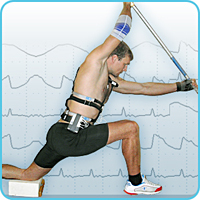
Portable and autonomous equipment (data are transmitted to a computer via telemetric channel or recorded onto a memory card) allows conducting medical
and scientific research under various conditions вАУ from a stationary scientific laboratory to field conditions (for example, training process,
performance of professional activities at the workplace, etc.).
Record can last from several minutes to 24 hours depending on the research task.
A large set of sensors and software suite allow recording a wide range of parameters, which characterize work of the major body systems,
and analyzing these data using various types of processing.
A uniform standard of data communication between wireless modules and standard sensor connector allow creating the required configuration
for different experiments.
Multiparameter record and analysis of cardiovascular, central and autonomic nervous systems parameters synchronously with EEG.
Record of physiological parameters in apparently healthy people is applied as a polyfunctional monitoring in sports medicine, studies of operator performance and scientific research.
In autonomous mode, equipment set can be supplemented with the module for synchronous recording of spatial movement (GPS module) during dynamic monitoring of physiological parameters at the workplace or the training site.
Provides quality record of video data synchronized with EEG for differential diagnosis of epileptic and non-epileptic phenomena.
Studies provide patient-friendly environment (a functional diagnostic room, hospital ward or at home). The patient can sleep, eat, read, watch TV, play, etc. A doctor or an assistant monitors their state, operation of the equipment and recording quality.
Mobile videomonitoring kit including video camera with portable camera's tripod and easily fitting into an additional bag is used with electroencephalograph-recorder "Mini" modification.
The customer is offered several types of mobile videomonitoring kits, which differ in the type of video camera: with night or daylight mode, optical or digital zoom, with rotator or without it, etc.
Detailed information about videomonitoring kit and software "Encephalan-Video"
A unique opportunity of continuous autonomous EEG videomonitoring
An original autonomous video recorder with an option of video record on the internal memory card sets up a new innovative level in ambulatory EEG studies and provides:
- continuous or fragmentary high-resolution video record with IR backlight for night mode,
- audio record of clinical events on integrated microphone,
- record of patient's events with the button on the video recorder.
All data recorded onto the internal memory card of the video recorder are accurately synchronized with EEG when transmitted to the computer.
Application of the original autonomous video recorder allows recording clinically significant behavioral episodes and paroxysmal events during continuous autonomous EEG monitoring (Holter-EEG) which, in turn, provides accurate differential diagnosis.
The video recorder is easy to operate and can be used both by medical staff and relatives of the patient during EEG recording at home.
Original concept of unification of hard- and software for electroencephalographs-recorders "Encephalan-EEGR-19/26" provides a unique opportunity of combination of autonomous patient transceiver-recorder ABP-10 with additional modules and sensors, which allows you to create unified multifunctional neuromodular diagnostic systems with synchronous recording of more than 30 different signals.
- Electroencephalogram
(up to 9 derivations), - DC-potential level in EEG derivations (up to 9 derivations),
- electrocardiogram (up to 3 derivations),
- electromyogram,
- envelope EMG (EEMG),
- electrooculogram (EOG),
- respiration effort (abdominal and thoracic),
- breathing airflow (nasal, oronasal),
- body position,
- movement activity,
- snore,
- tremor,
- oxygen saturation (SpO2),
- skin potential
(electrodermal activity), - galvanic skin response,
- photoplethysmogram,
- temperature,
- impedance-based pneumogram,
- impedance-based encephalogram,
- impedance plethysmogram (central hemodynamics),
- wetness,
- illumination,
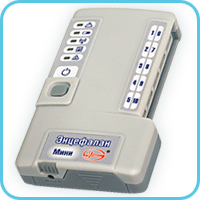
ABP-10 in the Poly-10 mode
Record of signals by 10 polygraphic channels.
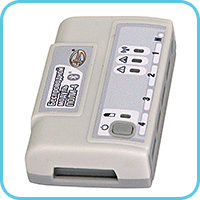
Wireless universal Poly-4 module
Record of signals by 4 polygraphic channels.
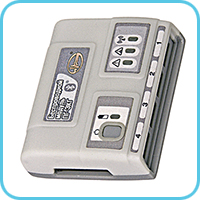
Wireless Module PG‑ECG
Record by 3 ECG channels and 1 impedance-based pneumogram channel.
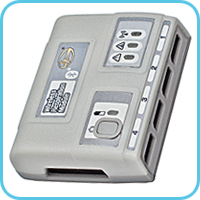
Wireless Respiration Module
Record of respiration parameters by 4 channels.
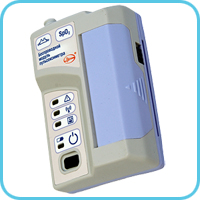
Wireless pulse oximeter module
Record of arterial blood oxygen saturation using SpO2 sensors.
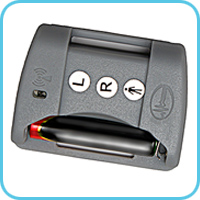
Wireless Movement Sensor
Record of data on movement activity in three dimensions.
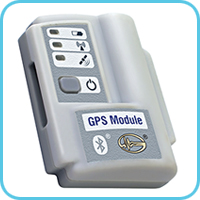
Wireless GPS-tracker
for tracking the position and motion path of a test person during autonomous studies.
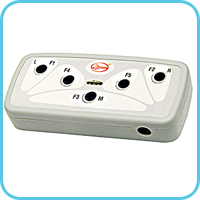
Patient button unit for detecting patient's response to presented stimulus.
is used for cognitive EP studies (CNV, P300) and EP studies with audiovisual stimulation.
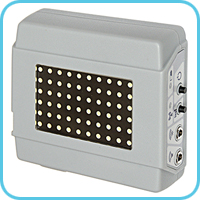
Stimulator SFN/FO-04 (autonomous photostimulator) with integrated LED matrix
for functional tests on photostimulation during EEG studies in telemetric mode, and for phono-, electrostimulation (required headphones and wireless electrostimulator).
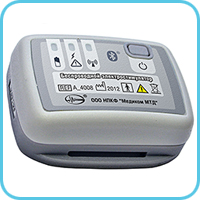
Wireless electrostimulator
for somatosensory stimulation for patient's responses testing in ICU, and for somatosensory evoked potentials studies.
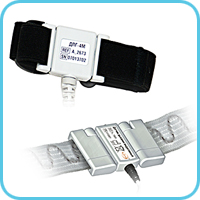
Respiration effort sensor ("RespEff", RIP)
evaluates parameters of abdominal and thoracic respiration (breathing rate and amplitude, duration of inhalation and exhalation phases) and detects breathing disorders.
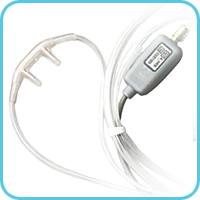
Pressure Airflow Sensor
("P-Flow")
evaluates parameters of nasal respiration (breathing rate and amplitude, duration of inhalation and exhalation phases) over pressure difference in nasal cannula
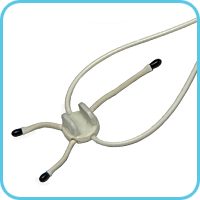
Oral and Oro-Nasal Airflow Sensors (Thermistor "T-Flow")
evaluates parameters of oral respiration and detection of breathing disorders basing on temperature changes of oral airflow.
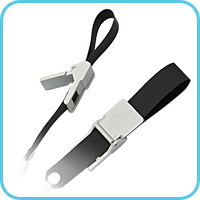
GSR Sensor
evaluates vegetative manifestations and emotional stress over phase component measurement.
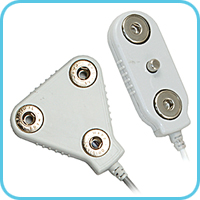
Envelope EMG Sensors (EEMG‑2 and EEMG‑3)
evaluates selected muscle tone over envelope EMG measurement
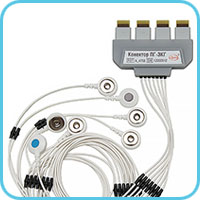
PG-ECG Connector
is used for signal record by 3 ECG channels and 1 reopulmonography channel. It's connected to wireless cardiorespiratory module (PG-ECG), wireless Poly-4 module or patient transceiver-recorder ABP-10 (in the Poly-10 mode)
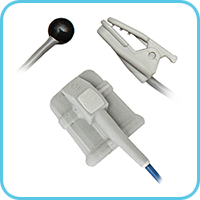
Photoplethysmogram sensors (fingertip, surface, and for ear)
evaluates peripheral blood circulation parameters, which characterize pulse blood filling and different vessels tone
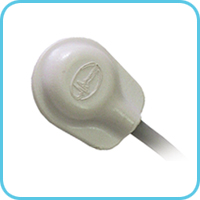
Snore Sensor
to detect and quantitatively evaluate the severity of snoring in one's sleep
Wired Movement Sensor
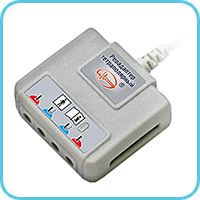
Tetrapolar Rheographic Adapter (RT) and sensor set
for study of central hemodynamics and heart's pumping ability by Sramek's method.
Bipolar Rheographic Adapter (RB) and sensor set
for study of cerebral (REG) and peripheral (RVG) blood circulation, and evaluation of central
hemodynamics parameters and heart's pumping ability by Tischenko's method.
Skin Conductance Sensor
evaluates vegetative manifestations and emotional stress over phase and tonic component measurement
EMG or skin potential
response (SPR) channel cable for two disposable electrodes
Temperature Sensor
evaluates skin surface temperature in selected body area
Wet Sensor
for bedwetting detection
Light Sensor
Set of EEG electrodes ES-EEG-10/20 "Encephalan-ES"
(variants, used with autonomous patient transceiver-recorder ABP-26)
Various types of EEG-electrodes with touchproof connector (connected to the EEG-9 connector)
For detailed illustrated catalog of Electroencephalograph-recorder "Encephalan-EEGR-19/26" "Mini" modification follow link
- "HRV" Software for Heart Rate Variability Analysis provides evaluation of autonomic nervous system (ANS) state on the basis of HRV study.
- "Encephalan-EP" Software for EP-studies вАУ provides long latency evoked potentials (EP) studies to stimuli of different modality (visual, auditory, somatosensory) with stimulators.
- "Encephalan-MPA" Software for multiparameter analysis of signals from polygraphical channels in combination with EEG signals (if additional wireless devices and sensors are purchased).
- "Encephalan-PSG" Software for Somnological studies (if additional wireless devices and sensors are purchased). Software provides analysis of sleep phases, automatic building and manual editing of hypnogramms, and also allocation of sleep events, formation of reports of sleep statistics, sleep stages distribution and respiratory disorders.
- "Encephalan-AVS" Software for EEG and EP studies with audiovisual stimulation. Software provides flexible creation and playback of scenarios of cognitive stimulation using graphic images, audio files and text information as stimuli.
- Analysis of Very Low Frequency Activity "Encephalan-VLFA". Software allows analyzing very slow EEG responses simultaneously with EEG recording by the same derivations.
- Three-dimensional localization of electrical activity sources "Encephalan-3D" displays a conditional source of electrical activity in the three planes of a brain cut in the form of a spatial cloud of dipoles, which allows us to localize the focus of epileptiform EEG activity or source EP components.
- Software for Functional Brain Asymmetry Analysis "Encephalan-FBA" provides visualization of cortico-cortical couplings maps by calculating the reciprocal functions (cross-correlation, cross-spectrum, the coherence function) for the diagnosis of inter- and intracortical dysfunctions, detection of the focuses of pathological activity, as well as for treatment monitoring.
- "Rehacor" Software for Functional Biocontrol with Biofeedback Training provides training and rehabilitation with biofeedback using various physiological parameters. ItвАЩs used for non-medicated reactivation of impaired functions, improving neural regulation, overcoming phobias and pathological addictions, optimization of psychophysiological state in athletes and people of stressful and responsible professions, as well as for overcoming attention deficit hyperactivity disorder in children and teenagers.
|
Phones: |
Frunze str., 68, Taganrog, |
| © 1997-2024 Medicom MTD Ltd All rights reserved | |

 Brochure
Brochure Catalog
Catalog Video
Video